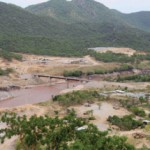 An Egyptian official says altering the dam’s impact on Egypt will require more money – and thus maybe funding from other Arab states
An Egyptian official says altering the dam’s impact on Egypt will require more money – and thus maybe funding from other Arab states
Egypt entered into negotiations with Ethiopia and Sudan in Khartoum on Monday with the objective of convincing Ethiopia to change the technical specifications of its Grand Renaissance Dam so as not to infringe on Egypt’s share of Nile water.
According to Egypt’s irrigation and water resources minister, Hossam El-Moghazi, the Egyptian delegation currently in Sudan has a new “vision” to present at the negotiations: explaining the threats the dam with its current technical specifications will pose on other countries.
Cairo and Addis Ababa have been at odds in recent months over the dam, which Egyptian officials say will impact its share of Nile water upon completion.
According to Diaa El-Qousi, a water expert, Egypt will never accept the dam with its current specifications or dimensions – a height of 150 meters and a storage capacity of 74 billion cubic meters.
“With the dam’s specifications and dimensions, Ethiopia will be capable of completely depriving Egypt of its water supply for one, two or even three years, which is something that Egypt will never accept,” Al-Qoussi explained.
He adds that the Egyptian delegation has to convince the Ethiopian side to return to the initial dimensions of the dam which date back to 1963.
“[Nile] Basin countries, especially the Ethiopian side, must understand that the Nile for Egypt is not a tool for development but a source of life,” said Al-Qousi.
Al-Qousi believes that Ethiopia has made a political, diplomatic and technical error since it started to construct the dam by not agreeing to consider a report issued by a committee of international experts. The report was never made public – but Egypt has given it importance as of late.
Sherif Eissa, head of the Nile water department at Egypt’s foreign ministry and a member of the Egyptian delegation in negotiations with Ethiopia, toldAl-Ahram that the committee’s report found that additional studies should have been made before construction work began to assess its environmental, socio-economic and hydraulic impacts.
“Experts have said that the studies conducted by Ethiopian authorities are Level 1 and that studies of Level 2 were needed to show the impact of the dam on downstream countries,” Eissa explained.




























Join Conversations